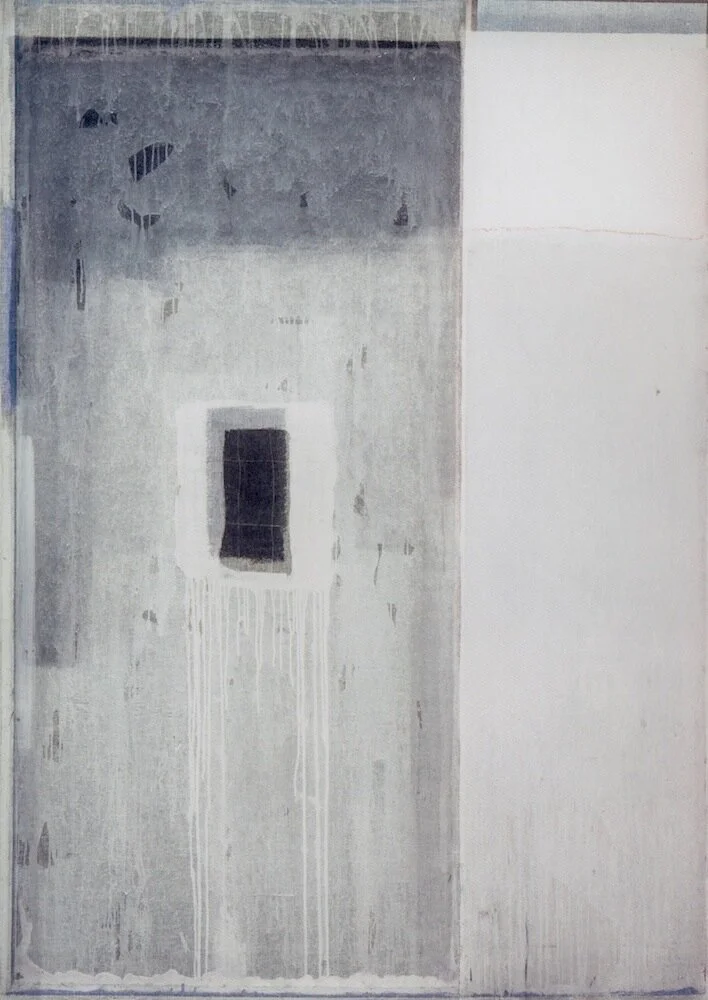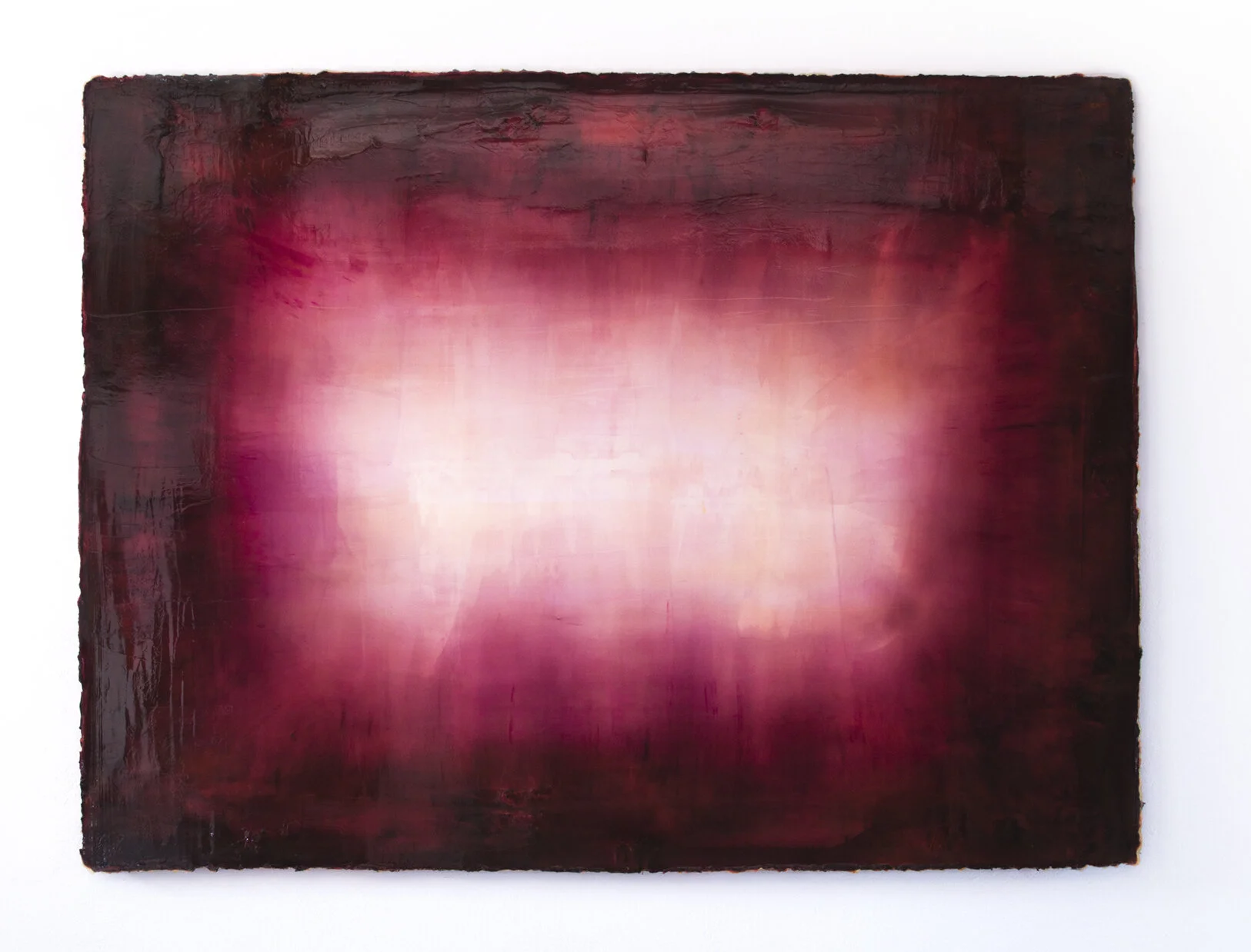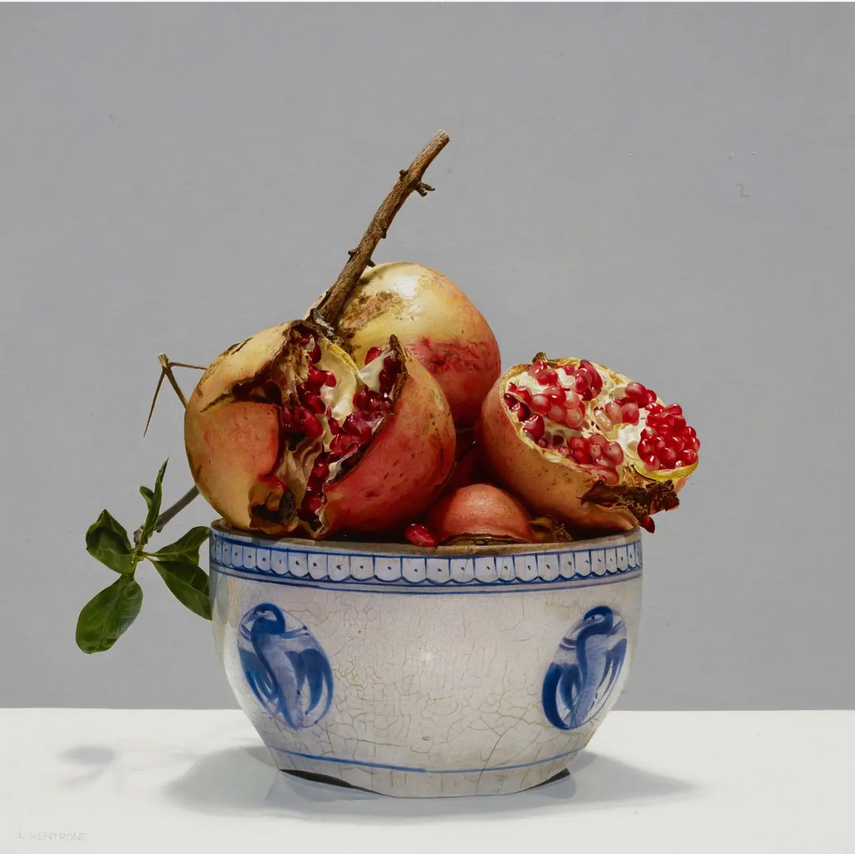GALLERIASTEFANOFORNI
Bologna, Italy
GALLERIASTEFANOFORNI
Elisa Grezzani was born in 1986 in Bressanone, Italy. She studied painting at the Academy of Art in Urbino, Italy (Marche, 2007–2011). Between 2012 and 2017 she coordinated the educational projects at the Museion in Bolzano and worked as assistant to the artist Robert Pan. As a basis for her work she uses wood and paper. Elisa usually acts simultaneously on fifteen or twenty works. This procedure gives her the possibility to maintain a certain psychic distance from the works. By superimposing layers of resin and flowing colors, a depth is created that reinforces the intention to create works that can be read on different levels. Working in parallel with several works makes it possible to put aesthetics in the foreground: the goal she aspires to, is to bring form and colour in tune, to achieve harmony and balance that becomes perceptible to the viewer and where the sense of beauty plays an important role. Confronting this complex theme shows that the boundary between beauty and ugliness, between harmony and dissonance can be very blurred and it is in this grey area that she feels at ease. The same is true for concepts such as abstraction or concretion: how much can shapes or colours be in contrast with each other, holding each other side by side or even strengthening each other? How long can you mix planes and layers before they are no longer readable as something figurative?
Igor Mitoraj was born in 1944 of a Polish mother and a French father in Oederan, Germany. He spends his youth in Krakow where he studies at the Academy of Fine Arts. Under the tutelage of Tadeusz Kantor, he is introduced to contemporary artists such as Andy Warhol, Lichtenstein, Merz and Klein. In 1968 he arrives in Paris to continue his studies at the École Nationale Supérieure des BeauxArts (National High School of Fine Arts).
He is awarded important prizes such as the “Montrouge Prix de la Sculpture” and is encouraged by the French minister of Culture who provides him with a studio at Montmartre. Mitoraj travels extensively, in particular to New York and Greece. After a visit to Pietrasanta in Tuscany, a sculptor’s paradise, the artist discovers marble as an ideal material for his sculptures, in addition to his previous use of terracotta and bronze.
In 1983, he chooses to make Italy his home and opens a studio in Pietrasanta, though he continues to maintain his Paris atelier. In 1986, Mitoraj accepts an invitation to participate in the XLII International Biennial Art Exhibition in Venice. In only a few years’ time, Mitoraj’s works of art are exhibited in many countries, often one-man shows as well as displayed in important museums. He begins to receive significant international commissions for his huge monumental sculptures both from private collectors as well as from the public sector. His works can be seen in London at the British Museum and Canary Wharf, at Bamberg and Krakow, in Paris at La Défence, at the Uffizi Museum and the Boboli Gardens in Florence, in Piazza del Carmine and the Scala Theatre in Milan as well as in Rome in Piazza Monte Grappa and Piazza Mignanelli.
In 2004, Mitoraj exhibits his monumental sculptures at the Tuileries Gardens of Paris, at the Mercati di Traiano in Rome and at the Royal Palace of Warsaw. In September 2005 with the city of Venice Civic Museums of Art and History inaugurates an exhibition entitled Mitoraj a Venezia, an exhibition of 21 sculptures, 16 of monumental size along with 25 inedited drawings. Other points of interest even extended to Mestre on the mainland in the San Giuliano Park and at the Civic Center. The exhibition has a huge success.
In 2011 his monumental sculptures are exhibited in the beautiful context of Temple Valley, in Sicily, while in the spring 2012 the solo exhibition Memoriae is unveiled, during the “Ravello Festival 2012”, in the amazing location of the Amalfitane Coast. In 2014 an important event for the artist take place: an exhibition to inaugurate the monumental complex in Miracoli Square (Pisa). The artist has worked between Italy and France until his death in Paris in October 2014.
Gianriccardo Piccoli, born in Milan in 1941, trained at the Academy of Brera under the guidance of Pompeo Borra and obtained a diploma in 1964. During the 1970s, Piccoli deepened his investigation of everyday objects and of the landscape, themes and subjects that were to recur during his later production. Public recognition of Piccoli’s work grew over the next decade, with the Premio Feltrinelli in 1984, the one-man exhibition at the Teatro Sociale of Bergamo and his participation in the Venice Biennial of 1986. He also exhibited in the public spaces of Wiesbaden in 1988 (Brunnenkolonnaden am Kurhaus) and held two retrospective exhibitions in 1990, at Tenero (in Switzerland, at the Galleria Matasci) and in Monza (at the Civic museums at the Serrone di Villa Reale). His works were now characterized by a grandeur that conferred on them a new visionary and dramatic dimension, where the principal role is played by light.
“I have always considered myself a figurative painter, and for a simple but fundamental reason: I can’t conceive – and still less paint – except in figurative terms, that is to say with a strong physical sensation of our corporeal presence on the earth. In this sense I feel that all my forms, even apparently informal ones, have a logical figurative interpretation”. (G. Piccoli). Definitely influential on Piccoli’s painting was a trip to the United States in 1984 and his reflections on certain episodes from the past, from the Lombard 17th century to Arnold Böcklin’s imagery. The drawings that followed in these years constitute a fine testimony to this interest, which was to assume a central role in his work during the 1990s.
The one-man exhibition in Basle in 1991 announced in no uncertain terms a new direction in technical experimentation, research on materials – with abundant use of gauze and of acetates – and study of light. Piccoli now created large-scale paintings by superimposing gauzes and acetates on the canvas. He also used industrial paints, alongside the more traditional oils and tempera, giving birth to images of great visual impact, but also of unexpected lightness.
His research into light gradually gained intensity during the 1990s, as lucidly described by the artisthimself: “Light has always been a fundamental element in my work: from the natural transparency of pastel interiors to the X-ray-style diversification of the thicknesses of the materials in my diptychs. It has guided my painting right up to the exclusive orchestration of my most recent canvases: a rethinking of light in the classical sense as an absolute value of immateriality”.
In 2010 the artist undertook a project in Roma and at Caravaggio, entitled 1610 Roma 2010. Omaggio a Caravaggio. For this occasion he created paintings of large format inspired by subjects and inventions of Caravaggio. In 2012 he started the collaboration with Galleria Stefano Forni of Bologna that organized a personal exhibition Tracce da un filo in 2014 and promoted him in Italian and international art fairs.
Renata Boero born in Genoa, 1936. He lives and works in Milan. He attended the N. Barabino Art School of Genoa, where he was a pupil of the painter Emilio Scanavino, a figure that will be of great importance in his training. After his studies he focuses on the relationship between sign and color, passing from oil painting to smooth plastic. A fundamental experience of his artistic growth is the period between 1960 and 1964, when he worked as assistant to Caterina Marcenaro, director of the Palazzo Rosso Museum in Genoa. Dedicating himself to restoration, the artist realizes that the canvases must be free from the frame as a "fragment of an infinite work". Subsequently he began teaching, first in Genoa and then in Milan, where he settled permanently in 1986 when he obtained the chair of painting at the Accademia di Brera. In this period the Chromograms are born, fruit of the search for roots and herbs with peculiar chromatic properties, analyzed in their chemical relations and in their modification through time, winking at alchemical processes. Precisely the relationship with the passing of time gives the Chromograms their most important attribute: the rhythm. In 1970 they were exhibited for the first time in Turin at the Martano Gallery. A variant of the first Chromograms are theGerminations, a project that the artist has been carrying out since 2009 and which collects in an artist's book created for Venezia Salva. Tribute to SimoneVeil, a side event of the 53rd Art Biennale. In 2012 she held a series of lectures and personal exhibitions in Argentina, at the University of Tucuman, Cordoba and at the Salta Museum. In 2019 he had a personal exhibition in Museo del Novecento in Milan.
An intense exhibition activity continues in public and private spaces in Italy and abroad, which he combines with his teaching commitment at NABA and at the Brera Academy in Milan and in Bregamo with Mario Cresci. Lives and works between Milan and Genoa.
Luciano Ventrone (Rome 1942-2021) attended Liceo Artistico in Rome. After graduation in 1946 he started studying Architecture. In 1968 he left the University and focused on painting. Even though Ventrone is internationally recognized as one of the master realist painters of his generation, he believes that his works are really about optics: “Painting is not about the mere representation of an object, but its colour and light,” he says. “The subject cannot be seen as it is but as an abstract element.” Ventrone studied at Rome’s Liceo Artistico and—in spite of experimenting with avant-garde methods—garnered attention for his academic realism and attention to anatomical detail; his life drawings would be published in a university textbook on human anatomy. Ventrone’s paintings still frequently feature nudes, as well as carefully arranged still lifes. For each of his works, Ventrone carefully stages his subject under bright studio lights, and photographs the arrangement for painting reference.
Ventrone’s paintings ‘invite a mood of pure contemplation’ from the viewer; they are works of masterful skill and supreme aesthetic beauty. Though he admits sharing a strong affinity for the work of Caravaggio, Ventrone does not consider himself a realist painter in the traditional sense. He paints real objects but, because of his utilisation of certain contemporary techniques as part of the artistic process, the objects depicted are transported into a metaphysical, hyper-real context. What we see in a Ventrone painting is not ‘real’ because it is not what we would see were we to look with the naked eye – We see more. Ventrone shows us things more fully and more clearly than they appear to us in reality; everything is in focus, everything can be scrutinised. He allows us to notice every blemish and admire every curve of flesh in a piece of fruit or on a naked female form. Set against monochromatic backgrounds of white, grey or black, the subject is lit from multiple angles, allowing for a full and objective appraisal of what we behold.
He did important personal exhibition all over the world in public and private spaces and his artworks are in important private and public collections.
Giorgio Bevignani born in 1955 in Citt di Castello (PG) is a multi-faceted artist working with unconventional materials across various formats including painting and sculpture. Bevignani currently lives and works in the countryside near Bologna, where he molds and forms diverse materials into distinctive conglomerations, round-like forms, that aggregate into larger constructions, relating the smaller elements to the larger form which are arranged and mounted together to create a larger, cohesive work. His creativity, which is considerable, emerges in the elegant combination of technical skill and conceptual knowledge.. Using special patinas, phosphorus tints, and colours, his idiosyncrasy of composition and form, both so playful and magical, combined and merged with a certain charm, create something new to the world. Bevignani’s work has a real presence, his connection to nature and culture, his organic plasticity, his use of positive and negative spaces, filled with awareness of form, create a body of work that seems to float, that go beyond our understanding of gravity, time, space, light, and balance.
One of his last project, the serie "Il Silenzio Nudo" is the result from an experimentation on silicone that, mixed with color on a base of several chromatic layers, confers depth to surfaces by exploiting the layering typical of sculpture rather than the painting technique of chiaroscuro. The result is a semi-transparent patina that resembles an organic tissue as soft and supple as skin under the fingers. In the following statement, the artist himself insightfully describes the sensations we feel when we approach these paintings in a way that invites us to penetrate this material made of transparencies and hazes, and almost pierce its surface as though it were denser, thicker and deeper than the actual layers patiently applied by the artist on the panels.
“Leopardi’s verses guide me in an hypnotic, almost dreamlike kind of gesture; the spatula slides on the surfaces and adds layer over layer of material and color until the fully focused image conveys a slight glow in the distance. It resembles the image you see when you close your eyes after looking at the sun. Although it slightly burns the retina, it leaves you still able to look at the image. It slowly penetrates – you just have to give it time; its power is slow and requires time.” (Giorgio Bevignani)
Recently the MOA Museum in Atami (Japan) acquired one of his artworks for its permanent collection and he has been invited in 2020 from Indixia Foundation in a big event in New York in the Sundaram Tagore Gallery of Chelsea. He is member of the Royal British Society of Sculptors since 2014. His works are in private collections at MOA - Museum of Art by Atami in Japan, Miami, New York, Milan, Frankfurt, Siena, Bologna, Bogota, Nice, Basel, Strasbourg, Brussels, Sao Paulo, Helsingborg.
Elisa Grezzani, Light sight, oil and resine on wood, 50x40 cm
Elisa Grezzani, Light sight, oil and resine on wood, 100 x 80 cm
Gianriccardo Piccoli, Il tempo ritrovato I, 2012, olio e pigmenti in polvere, pastello su tela, filo di ferro e olio su garza, 120 x 90 cm
Gianriccardo Piccoli, Porta Segreta, 2015-2016, olio e garza su legno, 204 x 140 cm
Giorgio Bevignani, Massa Solo 1, 2019, epoxy resin pigments, 43 x 32 x 24 cm
Giorgio Bevignani, Silenzio Nudo Solo 39, 2019, 150x200 cm
Luciano Ventrone, Danza intrecciata, oil on canvas, 60x60 cm
Luciano Ventrone, Eterno presente, 2010-2017, oil on canvas, 50 x 50 cm
Renata Boero, Kromogramma, 1979, colori naturali su tela, 255 x 170 cm









